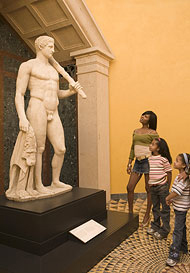 |
 |
 |
Grades/Level: Lower Elementary (K–2), Upper Elementary (3–5), Middle School (6–8), High School (9–12), Adult Learners
Subjects: Visual Arts
Time Required: Short Activity
20 minutes
Author: J. Paul Getty Museum Education Staff
|
 |
 |
 |
 |
 |
Activity Overview |
It's only natural for visitors to want to touch the beautiful works of art they see in the Villa. Usually they don't realize the cumulative damage that results when many people touch an object, even very lightly. Before your visit, try this classroom activity to help your students understand why they cannot touch the art on display at the Getty Villa. |
 |
 |
 |
Learning Objectives |
Students should be able to:
• Discuss the importance of preserving art for future generations.
• Develop an understanding of how art can be damaged by touching.
|
 |
 |
 |
 |
 |
Materials |
• Two ordinary pieces of white paper, about 4 x 5 inches
• Handout: Please do not touch this bear!
|
 |
 |
 |
|
|
 |
 |
Activity Steps |
Step 1: Take two pieces of ordinary white paper (about 4 x 5 in.) and pass one of them around the classroom. Ask each student to rub the piece of paper between his or her fingers for a moment before passing it along.
Step 2: After everyone has touched the paper, have students compare it to the piece that was not passed from person to person.
Step 3: Discuss how much dirt and oil is on the sheet that they touched and how these residues can damage works of art. Tell students that hundreds of people visit the Getty Villa every day, and speculate on what the paper might look like if thousands of people had touched it! Look at the picture of the bear’s paw on the "Please do not touch this bear!" handout for comparison.
Use the students' comments as a springboard for a discussion on the importance of preserving ancient art. Why is it important to preserve these works of art? What can we learn about the people who made or used the works of art at the Getty Villa? What works of art at home or in the community would they want to preserve? Why?
Fun Facts about the Antiquities Collection at the Getty Villa
• The oldest object is approximately 8,500 years old.
• The "newest" object was made in about A.D. 500.
• We call European art "ancient" when it dates to periods before the fall of the Western Roman Empire in A.D. 476.
• Conservators are people who clean and repair works of art. |
 |
 |
 |
| Students in the Museum at the Getty Villa |
 |
|
 |

